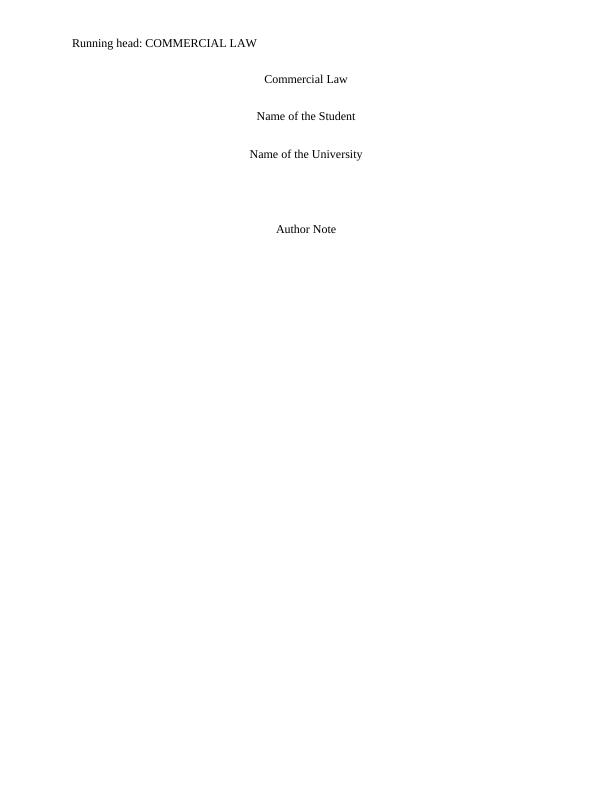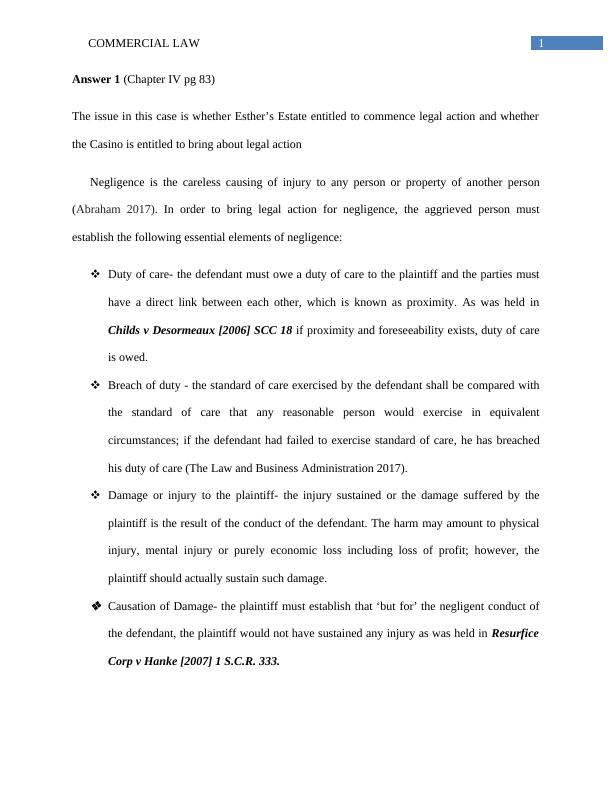Assignment of Commercial Law
Added on 2020-03-16
6 Pages1276 Words32 Views
Running head: COMMERCIAL LAWCommercial LawName of the StudentName of the UniversityAuthor Note

1COMMERCIAL LAWAnswer 1 (Chapter IV pg 83)The issue in this case is whether Esther’s Estate entitled to commence legal action and whetherthe Casino is entitled to bring about legal actionNegligence is the careless causing of injury to any person or property of another person(Abraham 2017). In order to bring legal action for negligence, the aggrieved person mustestablish the following essential elements of negligence:Duty of care- the defendant must owe a duty of care to the plaintiff and the parties musthave a direct link between each other, which is known as proximity. As was held inChilds v Desormeaux [2006] SCC 18 if proximity and foreseeability exists, duty of careis owed. Breach of duty - the standard of care exercised by the defendant shall be compared withthe standard of care that any reasonable person would exercise in equivalentcircumstances; if the defendant had failed to exercise standard of care, he has breachedhis duty of care (The Law and Business Administration 2017). Damage or injury to the plaintiff- the injury sustained or the damage suffered by theplaintiff is the result of the conduct of the defendant. The harm may amount to physicalinjury, mental injury or purely economic loss including loss of profit; however, theplaintiff should actually sustain such damage.Causation of Damage- the plaintiff must establish that ‘but for’ the negligent conduct ofthe defendant, the plaintiff would not have sustained any injury as was held in ResurficeCorp v Hanke [2007] 1 S.C.R. 333.

2COMMERCIAL LAWThe defendant may use the defense of voluntary assumption of risk to establish that theplaintiff was aware of the risk of harm before undertaking the activity and has given consent tosuch risk of harm voluntarily. The doctrine of Eggshell skull or the thin skull rule states that thetortfeasor is liable for all the consequences resulting from the actions or omissions that causedinjury to the plaintiff even if the damage suffered is unusually high, even if the tortfeasor did notintend to cause injury. It would include social, physical and economic attributes that might makethe plaintiff more vulnerable to the injury sustained (The Law and Business Administration2017). In the given scenario, Zooland Ltd owed a duty of care towards the patrons as anyconduct or omission may cause direct damage or harm to the patrons. Thus, there is a linkbetween the patrons and the Zooland ltd, which makes its liable for exercising duty of care. Thepatrons included Esther 65 years old who lost consciousness seeing the fake arm and the blood.The conduct set loose the bear and caused mental harm to Esther who was also a heart patient.The entire crowd also panicked from such conduct, which was reasonably foreseeable and anyreasonable person would not have acted in such a manner. In case of the casino, Chauncey was shocked seeing the bear and hit the hydrotransformer and caused damage to the Casino. Under both the circumstances, the thin skull ruleshould be applicable according to which the tortfeasor shall be liable for the unusually highdamage caused or injuries sustained by Esther and Casino even if the harm was not intended asthe harm included a physical, mental harm and pecuniary loss caused to Esther and pecuniaryloss suffered by the Casino. Hence, Both Esther and the Casino shall be liable to bring legalaction against Zooland Ltd.

End of preview
Want to access all the pages? Upload your documents or become a member.
Related Documents
Commercial Law: Negligence and Contractual Issueslg...
|9
|2275
|492
Commercial law : Sample Assignment PDFlg...
|14
|3265
|20
(Doc) Commercial Law : Assignmentlg...
|8
|1387
|36
Intentional Plagiarism in Stott's Colleges Bachelor of Business Assessment Cover Sheetlg...
|5
|1157
|489
Law Assignment: Tort of Negligencelg...
|9
|1722
|538
Commercial Law: Negligence and Misrepresentationlg...
|9
|1821
|125
